
Elizabeth Morse (1869 - January 10, 1948) founded the Morse School of Expression in 1907. [1]

Elizabeth Morse (1869 - January 10, 1948) founded the Morse School of Expression in 1907. [1]
Bessie Morse grew up in a farm in Jefferson County, Missouri, and later moved to De Soto, Missouri. [2]
She attended a country school until thirteen years old, then the De Soto High School, the Kirksville Normal School, Soper School of Oratory in Chicago, and schools of that kind in Boston and New York. In New York she assisted the principal of the American Academy of Dramatic Art, and since then she visited every year in Boston and Chicago for the purpose of getting new ideas. [3]
She moved from DeSoto to St. Louis in 1900. [2] She conducted private classes in her studio for five years. Before that she traveled under the management of a lyceum bureau as a reader, touring the North, South and West under their auspices, also giving private recitals during that time. For ten years Morse gave lecture recitals. [3]
The Morse School of Expression was founded by Bessie Morse in 1907 and was hosted in the Musical Arts Building, at 457 Boyle Avenue, St. Louis. [2] [4] Morse was also principal of the school. Moreover, she acted as judge in declamatory contests. According to the St. Louis Star "her success is due to her thorough understanding of her chosen art, to her admirable personality, also her zeal and devotion to her profession. The Morse School of Expression was among the best equipped dramatic schools in the Middle West. [5]
The Morse School of Expression taught elocution, oratory, literature, dramatic art, physical culture, and aesthetic dancing. The method adopted by Morse, who was also a well-known platform lecturer, was that of natural expression. The central idea was the training of the mind, body and voice at the same time. When the voice was thoroughly trained it responded perfectly to every thought, and the body likewise, so that there was perfect harmony. [3]
Among the graduates Morse sent out from her school who were distinguishing themselves were: Maud W. Barnes, director of the Department of Expression in Ouachita College, Arkadelphia, Arkansas, one of the largest seminaries in that State; Valerine Dunn, who went first with the Suburban Stock Company, and then was director of the Department of expression in the Visitation Convent of Mobile, Alabama; Mina Pearl Finger of Marissa, Illinois, who occupied the same position for the Lindenwood College, St. Charles, Missouri; Eunice Green, connected with the Sacred Heart Convent in St. Charles, where she was the director of physical culture; Naomi Weston Childers, gained success as the ingenue in the "Madame X" Company of Henry W. Savage; Geraldine Albert, teacher of Expression in the Academy of the Visitation, St. Louis; Madeline McNabb, studied in Boston and made a reputation in that city; Caroline Delano Johnson, of St. Louis, [3] Cathryn Cravens, commentator on radio, Kathrine Snodgrass, also known as Jane Porter, who conducted the Magic Kitchen program on radio, Therese Wittler, winner of the Samuel French award and Marjorie Moffett, actress and impersonator. [2]
Morse's school was the only one of its kind conducted by a white woman in St. Louis. [3]
In 1917 Morse wrote Principles of Expression, which she used as a text book in her school. She later wrote The Art of Speech. [2]
In 1923 she spent a summer in Honolulu giving recitals in private homes, and the next winter did the same in New York City. [2]
She was a charter member of the Society of St. Louis Authors and a member of the Cornelia Green Chapter of the Daughters of the American Revolution. [4]
She died January 10, 1948, and is buried in the Old Cemetery at DeSoto, Missouri. [4]
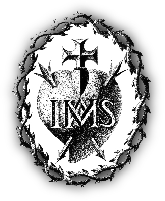
The Order of the Visitation of Holy Mary, abbreviated VSM and also known as the Visitandines, is a Catholic religious order of Pontifical Right for women. Members of the order are also known as the Salesian Sisters or, more commonly as the Visitation Sisters.

Charles Wesley Emerson (1837–1908) was the founder, namesake and first president of Emerson College in Boston, Massachusetts. Charles Emerson was also a minister with the Unitarian Church and the author of a number of books dealing with oratory.
The Society of Helpers, formerly known as the Society of the Helpers of the Holy Souls, is a Roman Catholic religious congregation of women founded in Paris, France, in 1856, with the objective of assisting the souls in Purgatory through their service to the needy of the world. The Sisters use the postnominal initials of "A.P." in Europe, or, alternately, "H.H.S" in English-speaking countries.
Virgil Horace Barber was an American Jesuit.
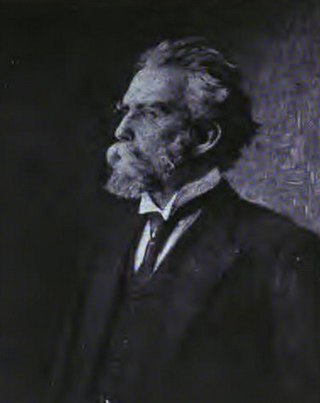
Samuel Silas Curry was an American professor of elocution and vocal expression. He is the namesake of Curry College in Milton, Massachusetts.

Genevieve Stebbins was an American author, teacher of her system of Harmonic Gymnastics and performer of the Delsarte system of expression. She published four books and was the founder of the New York School of Expression.
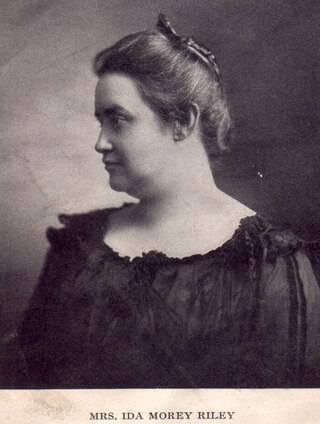
Ida Morey Riley was a teacher of Elocution and Expression in the late 19th century. She is known for being a co-founder and First Co-president of Columbia College Chicago.

Mary Helena Zachos was an author, dramatic reader, playwright, professor, and elocutionist. She was the daughter of abolitionist and women's rights activist John Celivergos Zachos. Her father also wrote countless books in the field of elocution and was the library curator and a professor at Cooper Union twelve years after the founding of the institution. Helena followed in her father's footsteps. She was a faculty member at the same institution for over forty-two years from 1897 to 1939 teaching elocution, oratory debate, and parliamentary procedure.
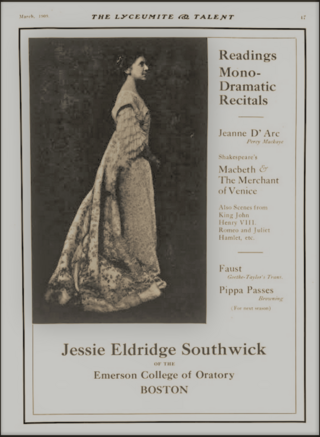
Jessie Eldridge Southwick was an American elocutionist, teacher, author and poet. She was active in the Chautauqua and Lyceum movements of the late 19th and early 20th centuries, performing around the United States as well as internationally. She influenced oratory through active involvement in emerging organizations, writing textbooks and teaching expressive voice culture and platform performance at Emerson College and elsewhere.
Jerusha Booth Barber, in religion, Sister Mary Augustine was a 19th-century American educator and Visitation sister. She entered the Georgetown Visitation Convent in 1818, with her husband entering the Jesuits. She founded a convent of visitation in Kaskaskia, Illinois, in 1836, remaining there till 1844. She taught in a convent in St. Louis, Missouri, from 1844 till 1848, and in Mobile, Alabama, until the time of her death. Her only son, Samuel, became a Jesuit, and her four daughters entered the convent.
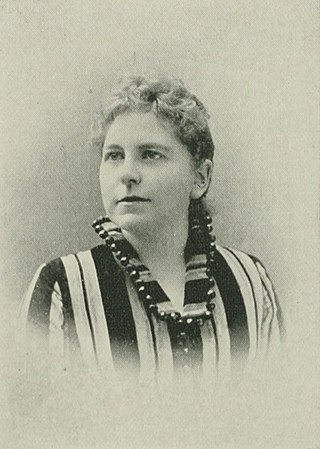
Elizabeth Marney Conner was a 19th-century American dramatic reader and educator, and the founder of the Buffalo School of Elocution. She published recitations in both prose and verse, and was also the author of an operetta.
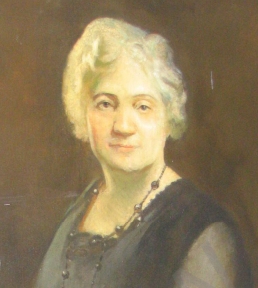
Anna Baright Curry was an educator and the founder of Curry College in Milton, Massachusetts.
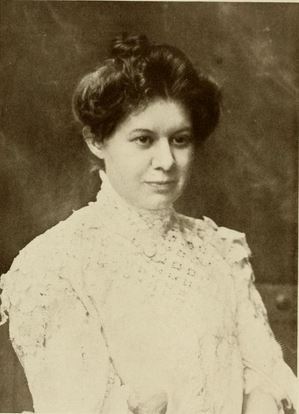
Annie Berenice Crumb Wyer was an American pianist, composer, and lecturer. Wyer composed for both piano and organ, and wrote art song and works for violin. She collaborated with Ethan Allen Taussig in performances of spoken recitation accompanied by the piano.
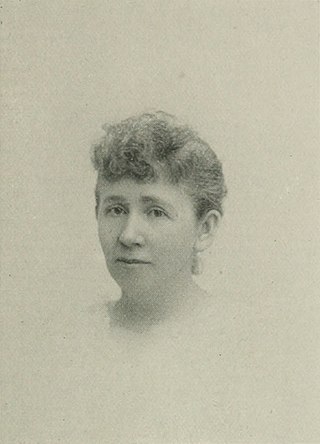
Edna Chaffee Noble was an American elocutionist. She was the founder of the Training School of Elocution and English Literature in Detroit, Michigan, and the Chaffee-Noble School of Expression in London, England. She served as president of the Michigan Association of Elocutionists in 1899.

Maria Brace Kimball was an American elocutionist who taught, lectured, and wrote on the subject. She was an instructor in elocution and lecturer on dramatic literature in the American Academy of Dramatic Arts; lecturer on French theatre and dramatic literature in schools; teacher of elocution in Brearley School, New York City, 1883–92. She was the author of A Text Book of Elocution (1892) and A Soldier-doctor of our army, James P. Kimball (1917), as well as various contributions to periodicals.
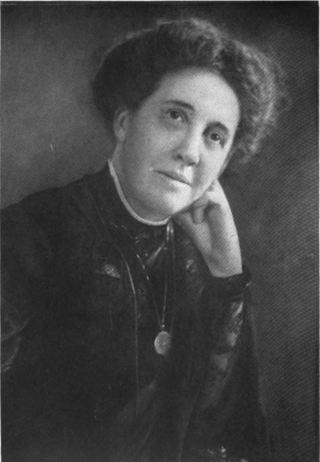
Lily C. Whitaker was an American educator and author. She contributed to the Southern Quarterly, under her father's direction and wrote for the New Orleans press. In addition to a poetry collection, Donata and Other Poems (1880), and a textbook, Spoken thought : a text book on vocal expression for use in high schools, normal schools and colleges (1927), she wrote several plays. Whitaker was elected president of the New Orleans Educational Association, and served as principal of one of the largest public schools in that city. She founded the first school of speech and oratory in the Southern United States.

Cora Stuart Wheeler was a 19th-century American poet and author. She was one of the most successful short-story writers of the day. It was during the civil war, as a girl in her father's committee-room at the Capitol, during President Lincoln's time, that ideas were formed which developed into her verse of later years. Wheeler, a well-known literary worker and journalist in her day, wrote verse, bits of humor, biographies, and racy, thrilling stories. She gave instructive, entertaining lectures, through which ran good-natured wit and purpose.
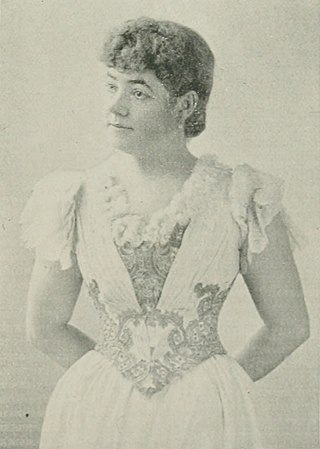
Sarah Lord Bailey was a British-born American elocutionist and teacher of dramatic elocution.
Dora Adele Shoemaker was an American educator, poet, and playwright.
Emma Priscilla Scott (1868-1940) was an educator and author, born around 1868 in Waterdown (Hamilton), Ontario, daughter of the Reverend James Scott and Elizabeth Cunningham, both of Irish origin. She married William Bryant Raff on 6 June 1894 in Owen Sound, Ontario. They had one daughter, Dorothy Victoria. Raff died in 1897. She married George Gallie Nasmith, a bacteriologist with the Canadian Army Medical Corps, on 20 January 1916 in Toronto. They had no children. She died in Toronto on 16 February 1940.